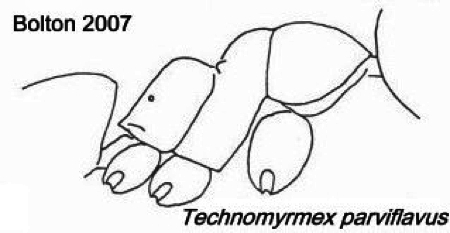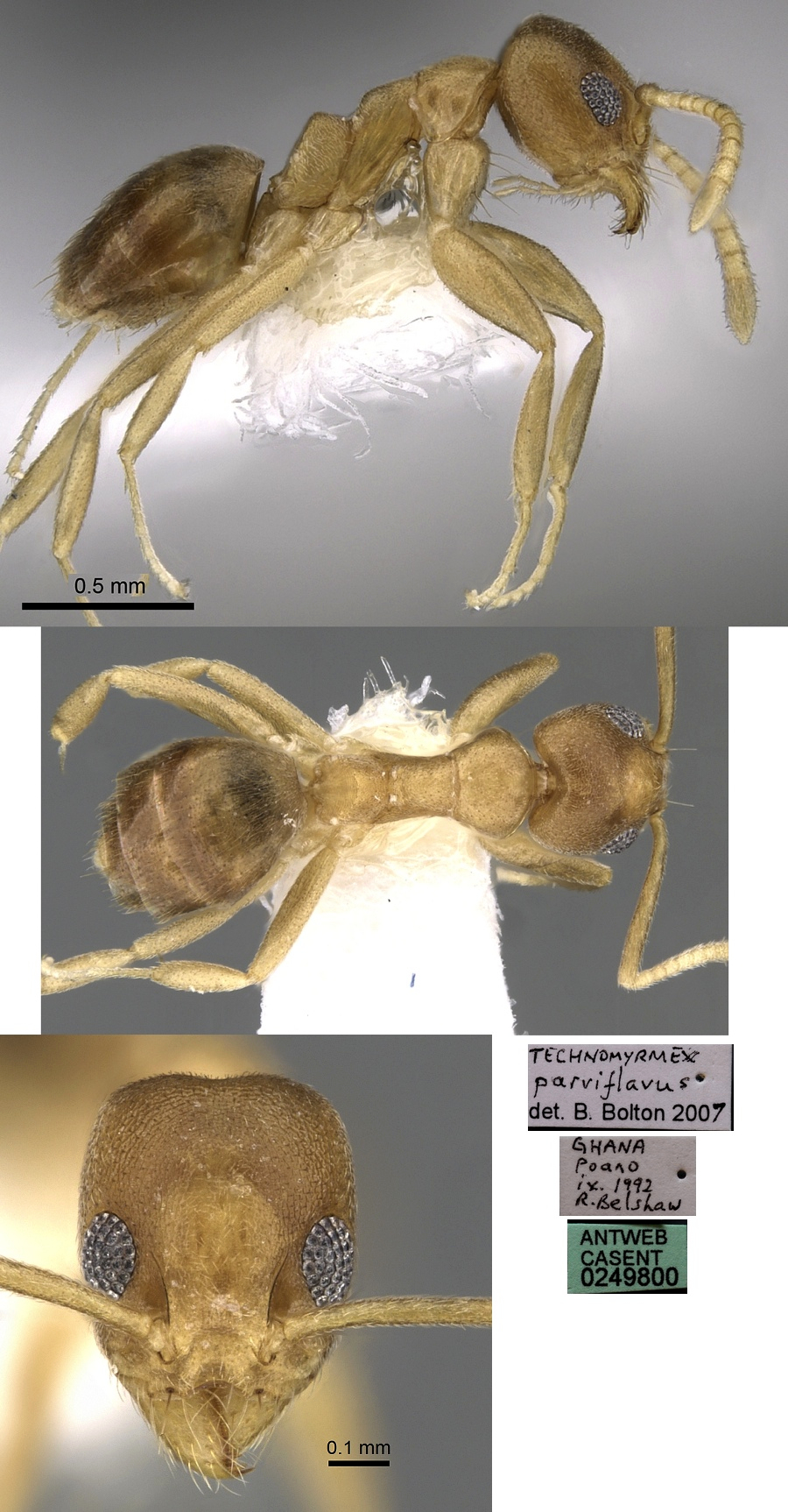Technomyrmex (T.) parviflavus Bolton
  Type location Ghana
(Technomyrmex parviflavus sp.
n., Bolton, 2007: 31, illustrated, worker) from Bunso, collected by R
Belshaw, leaf litter, ii.1992 - see below Type location Ghana
(Technomyrmex parviflavus sp.
n., Bolton, 2007: 31, illustrated, worker) from Bunso, collected by R
Belshaw, leaf litter, ii.1992 - see below  . .
|
 Bolton's
(2007) description is at Bolton's
(2007) description is at  . .
Note - Bolton states the propodeal profile is
"extremely shallowly convex .. and meeting the straight declivity
through a blunted angle; straight-line length of dorsum distinctly less
than depth of declivity to the spiracle". The illustration in Bolton's
paper is listed as Fig. 15 and does not match that description and,
given the propodeal profile in the other species he describes as close
relatives - Technomyrmex
senex and Technomyrmex
sycorax, it seems certain that image was incorrect. The correct
image appears to be Fig. 13, labelled as T. vexatus from
Morocco - thus I transposed the images (as shown right) [T.
vexatus has the relatively domed propodeal profile]. The Antweb images now (2014) confirm this.
|
 Nigeria specimens (as Technomyrmex
species
species T4, Taylor, 1978: 57).
WORKER. Size variable. TL 2.03-2.49 mm, HL 0.62-0.72, HW 0.54-0.62, SL
0.62-0.72, PW 0.36-0.40 Nigeria specimens (as Technomyrmex
species
species T4, Taylor, 1978: 57).
WORKER. Size variable. TL 2.03-2.49 mm, HL 0.62-0.72, HW 0.54-0.62, SL
0.62-0.72, PW 0.36-0.40
Colour yellow-brown but gaster darker. Appearance dull to due a very
fine overall pubescence and a fine reticulate sculpturation. The latter
forms a distinct longitudinal pattern on the pronotum. Erect hairs only
on the ventral apex of the gaster, on the clypeus and a single short
seta near the base of the fore coxa. In profile, the alitrunk is
smoothly convex through the pronotum and mesonotum; the propodeum has
an obtuse curved angle and the declivity is flat.
My only collections were made at night in a house at the Cocoa Research
Institute of Nigeria, Idi Ayunre, foraging in a column from a nest
within the wall. The specimens probably are among those listed by Bolton
As Technomyrmex species T4
in Taylor (1981) but listed without reference by Bolton (2007).
|
 The
photomontage of the holotype worker is
collated from - http://www.antweb.org/specimen.do?name=casent0903059 The
photomontage of the holotype worker is
collated from - http://www.antweb.org/specimen.do?name=casent0903059
|
 The
photomontage of a worker, apparently from the type collection, is
collated from - http://www.antweb.org/specimen.do?name=casent0249800 The
photomontage of a worker, apparently from the type collection, is
collated from - http://www.antweb.org/specimen.do?name=casent0249800
|
 Note:
For some time, I have suspected that the automontage technique used by
Antweb and many others can produce a somewhat distorted compound image.
Comparing the two specimens above and my drawing (by using digital
imagery software, layering and playing with the opacity tool), I
composed this image. With the head profiles all on the same scale, it
is clear that, although slight, the automontage frontal view of the
head, particularly of the holotype, is disproportionally elongated. Note:
For some time, I have suspected that the automontage technique used by
Antweb and many others can produce a somewhat distorted compound image.
Comparing the two specimens above and my drawing (by using digital
imagery software, layering and playing with the opacity tool), I
composed this image. With the head profiles all on the same scale, it
is clear that, although slight, the automontage frontal view of the
head, particularly of the holotype, is disproportionally elongated.
|
|
Oxford University Museum
specimens
Technomyrmex parviflavus
B Taylor det. |
Cameroun
G Debout & A Dalecky
Cameroon 02
|
24.iii.2001
EBO
2°33.97' N
9°50.62' E
|
on sandy soil and
surface near the beach
|
2
|
 |
|
 The photomontage is of
workers collected in Cameroun
- south-western tropical coastal forest area between Edéa and Campo
(McKey Wolbachia project, Cameroon 2) The photomontage is of
workers collected in Cameroun
- south-western tropical coastal forest area between Edéa and Campo
(McKey Wolbachia project, Cameroon 2)
Previously misdiagnosed by me as Tapinoma
melanocephalum.
|
|